Bánh tráng mè (roasted black sesame rice paper)
It was one of those days in Vietnam where I just wanted to walk and explore… there was nothing on the agenda (lucky me) and the weather was nice and cool and finally not raining. Here I am in Danang, a coastal city in the heart of Central Vietnam.
It was reasonably early in the morning, yet the streets were already bustling – this is what I love about Vietnam, and it is always good to get up and grab some street food for breakfast because those particular stalls only open for a few hours and will either close for the remainder of the day or change to sell another specific dish in the evening.
Crossing the streets in Vietnam is never pleasant, you must look both ways and just keep steadily walking along, even though the traffic in Danang is fairly passive, the same unspoken road rules apply between driver and pedestrian, go but go with steady caution.
I walked down the main road and turned down a picturesque street, taking photos of laundry hanging outside people’s houses, I know it’s weird, but I am fascinated by the colours, textures, and simple elements of everyday life in Vietnam. I stopped to see a few racks of rice paper sheets drying in the sun, as I walked closer, I saw a mini handmade production of bánh tráng mè in the process. I stopped to watch for a good 30 minutes and spoke to the daughter of the owner, who spoke perfect English beautifully.
What is bánh tráng mè
Bánh tráng mè was once a simple snack that was portable, easy to keep, and provided fast and efficient sustenance for labourers and workers. It then became a staple in the everyday diet, as an accompaniment to dishes and even a perfect pairing with beer.
The deliciousness ( yes this is a word) is prevalent in its simplicity. A batter of rice flour and water is mixed with roasted black sesame seeds, with just a touch of sugar. It is then thinly ladled onto cast iron pans that are heated by an open charcoal fire. When the batter is heated through, it is carefully taken off with a stick and placed flat on a large wooden frame to dry out in the sun.
When the rice paper is completely dry, it is taken off, stacked, and packaged, ready to be dispatched to the markets and restaurants. I was fascinated by how methodical and quick this little home factory made the bánh tráng mè, years of practice resulted in a beautifully timed choreography.
The last process of Bánh tráng mè lies with the end consumer. It is heated over coals or on a grill until it puffs up and is slightly golden, then served on its own, with a variety of sauces, soup, or noodles.
The owners daughter said they produce about 500 of Bánh tráng mè a day and they are one of the few places that make it by hand in Danang. The method has gone to mass manufacturing to provide consistency and quantity for the increasing number of restaurants that are constantly popping up in Vietnam.
“Here, try one” I took the bánh tráng mè ever so gratefully and took my first crunchy bite, maybe it was because I had seen them made in front of me or my heart was full from the genuine conversation exchange, it was the best bánh tráng mè I had tasted.
We said our goodbyes and I turned to walk down the street, they continued to make that bánh tráng mè, like they have done for the past 20 years.
Laying out the recently steamed bánh tráng mè
Bánh tráng mè drying



